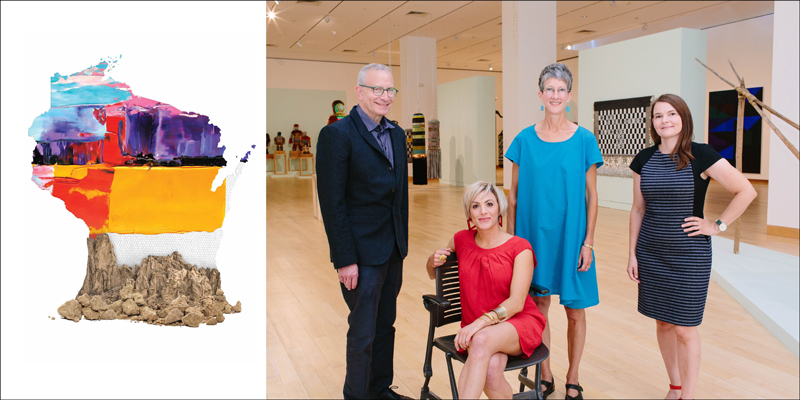By Hywania Thompson
The artworks are varied—abstract, monochromatic, works using materials like sand, yarn and aluminum, and much more. They represent the best of contemporary art being created throughout the state and they’ll be on display in Madison this month at the Wisconsin Triennial.
Selecting artists for the triennial, held once every three years at the Madison Museum of Contemporary Art, is a well-thought out, deliberate process, including visits to artists’ studios. Four MMoCA curators, Sheri Castelnuovo, Stephen Fleischman, Leah Kolb and Mel Becker Solomon, did the work of visiting and choosing the artists. Castelnuovo and Fleischman have both been at the museum since 1991 and helped organize several previous triennials. This is the third triennial for Kolb and the first for Becker Solomon, who most recently worked as a research curator at the Art Institute of Chicago.
The team sifted through some 500 applications and had challenging conversations about how to narrow them down.
Once they made a first round of selections, the four curators split studio visits among them. Fleischman, MMoCA’s director, is passionate about traveling the state for the visits. “It allows you to go to different areas of the state and meet the artists, experience their work firsthand and talk with them in a very direct way about what they’re up to and what’s informing their work,” he says.
Kolb, the museum’s curator of exhibitions, says the studio visits give curators an opportunity to see what’s happening on the local art scene. The lustrous gems they discover are impressive. “I am amazed and in awe of the stunning work that’s being created behind closed doors—in basements, attics, garages and old warehouses across the state,” Becker Solomon says.
After six weeks of studio visits this summer, the curators came back together to discuss their experiences. “We talk about the breadth of what we saw,” Fleishman says. “We try to capture that in the exhibition—different stylistic sensibilities, different media, geographic location and backgrounds of the artists.”
The curators don’t make immediate decisions but have many discussions before selecting the finalists. “It’s a tough process just because there are so many artists worthy of having their work shown,” Kolb says. Participation in the triennial is prestigious and often builds the careers of artists.
One of the things the curators discussed is representing new voices. “We have a lot of new, diverse voices in the exhibition this year, and most of the artists have not been in the triennial before,” Becker Solomon says.
This triennial includes 32 individual artists, as well as two groups of artists working together.
With the exception of its opening, the exhibition is free of charge. Castelnuovo hopes this will draw people in. “We hope that the galleries are full of people interested in seeing what artists living in Wisconsin are thinking about and creating,” she says. “I also hope that MMoCA’s school tour program, which offers public schools field trip subsidies and Gallery Talks series, are at capacity.”
Becker Solomon wants people to feel a sense of pride for the artists. “They are often juggling other careers and working late at night,” she says. “It’s fun to share those unique voices in our communities and create a space for inspiration for artists of all ages—it’s never too late to create, make and be in a museum exhibition.”
Spotlight on Two Triennial Artists
When you check out the Wisconsin Triennial don’t miss the work of several local women, including Jennifer Bucheit and Marianne Fairbanks.
After moving to the Madison area in 2011, Bucheit volunteered at the Madison Museum of Contemporary Art. Now her own work is part of the Triennial exhibition.
Bucheit worked as a graphic artist for several years before returning to school for photography. She received her master’s degree in fine arts last December from the Academy of Art University in San Francisco.
Her work on display at the triennial is an interactive exhibit that addresses consumer- ism and its effects on the environment. She doesn’t want visitors to be shy when view- ing her work—you’re welcome to rotate the frames and fully engage with her five pieces. “What’s kind of unique about this project is that the prints are printed on consumer packaging so they’re double sided,” Bucheit says. “I hope people come away with reflect- ing on their own consumer habits and make small changes that will make a difference for everybody.”
Marianne Fairbanks was thrilled when she found out she had been chosen for the triennial. In addition to creating her own art, Fairbanks is a professor in the design studies department at UW-Madison.
Fairbanks says her solo art, her research and her work in Weaving Lab, the social project she created that explores textiles produced in a public space, are all connected. “While I am a weaver, I am also a materialist,” Fairbanks says. “I sometimes start the work from an idea and sometimes from the material, its manipulation and its potential meaning.”
Visitors can expect “finely detailed work weavings, bold colors and patterns” when they view Fairbanks’ work. “With playfulness and wit, the work destabilizes conventional gender-based value systems of hard and soft form-making, and encourages a deep engagement with our material world,” Fairbanks says. She hopes people will enjoy looking at her work and hopes they’ll ask questions that will keep them looking.
Read about more of the artists featured in the Wisconsin Triennial in our October issue.




